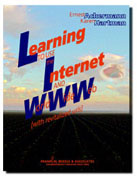| Summary Terms Exercises |
|
Chapter 9 |
|
|---|---|
Supplemental Material (available on CD with book)
- "Writing Web Pages With Tables" (PDF)
- "HTML Tags" A table of the HTML tags discussed in this chapter (PDF)
- "Web Page Evaluation Checklist" (PDF)
- "Beyond HTML" A survey of other technologies used to create Web pages including XHTML, Java, JavaScript, and CGI (PDF)
- "Activity 9. Writing Web Pages" The source files and images used in the activity in this chapter
- "Exercise1.htm" The source file necessary to complete Exercise
1 below (HTML)
- URLs from the chapter (HTML)
- Copies of the review questions in quiz format (PDF)
Web pages are text or ASCII files in which HTML, hypertext markup language, has been added to specify the page's format, images to be displayed, hyperlinks, and possibly other elements. A Web browser interprets the HTML in the file, called the source file, and then displays the Web page accordingly. One part of writing Web pages is learning how to use HTML to design and implement appropriate and effective pages.
The source file for a Web page consists of text, URLs, and other elements along with tags or directives written according to the rules of HTML. HTML tags are enclosed between < and >. Some tags occur in pairs with the second being identical to the first, except with a slash added after the < to indicate that it's the matching tag; for example, <i> and </i> would work together to indicate text to be italicized. Other tags occur as single entities, such as <hr>. Tags should be written using lowercase letters, although HTML ignores the case of letters in a tag. With URLs, you have to pay strict attention to the case of the letters. An HTML document should have two parts, a heading and a body. The heading contains the title for the Web page, and the body holds the content-the text and images that will be displayed on the actual Web page. HTML tags can be used for some control over vertical spacing, such as ending lines and starting paragraphs, but otherwise most horizontal and vertical spacing within a source file is ignored. The browser takes care of fitting the page within its own window. HTML tags also can be used to specify up to six levels of headings in a document and can control whether text is displayed in bold, italic, or plain font. Lists-numbered, bulleted, or descriptive-can be specified with HTML tags. HTML is also used to create and specify hyperlinks and to place images within a Web page. The hyperlinks start with a tag of the form <a href="URL"> (where you substitute an actual URL for URL), followed by text or a tag for an image, and then terminated with </a>. The following:
It appears that <a href="http://users.mwc.edu/~ernie/index.html"> Ernest Ackermann</a> is the culprit!
would appear on a Web page as
It appears that Ernest Ackermann is the culprit!
From this Web page, clicking on Ernest Ackermann would cause the browser to open the location associated with http://users.mwc.edu/~ernie/index.html. Images are put into Web pages using a tag of the form <img src="URL"> where the URL for an image is put in the place of URL. The image must be either in GIF or JPEG format to be displayed by a Web browser. Text can be aligned with an image, either at the top, middle, or bottom. Images can be placed to the left or right of text. HTML has many other tags, but we've covered the basic ones in this chapter.
Because a source file is in text format, it can be created with any editor or word-processing program that allows you to save a file in text or ASCII form. No special program is needed to create a Web page, but when you have a lot of pages to create or you have to convert information from another format into a Web document, it's useful to have a program designed to create Web pages. Some are available as shareware, some as freeware, and some must be purchased before using them.
Learning HTML is one part of being able to create interesting and effective Web pages. You also need to be concerned with the content and the layout of the content.
Designing, creating, or writing a Web page is generally very satisfying.
You create something and then let people around the world see it. Before
making the page available to the world, you can develop it on your computer
and view it with your own Web browser. If you need help or want to learn
more about creating or authoring Web pages, there are a number of resources
and guides available on the Web. What fun!
Terms
| alternate
text ASCII CGI HTML hyperlink Java JavaScript |
source file tag text file Uniform Resource Locator (URL) Web page XHTML |
Exercises
Available on CD with book.
This material has been prepared to accompany the book "Learning to Use the Internet and the World Wide Web" (ISBN 1-887902-78-3) by Ernest Ackermann and Karen Hartman, and published by Franklin, Beedle and Associates, Incorporated, Wilsonville, OR. © 2002. No part of this may be reproduced, stored in a retrieval system, or transcribed without permission of the publisher.
| You can help support this site by buying books, CDs, and other items after clicking on this link. |  |
Number of visits here since May 10, 2002.
